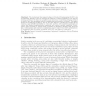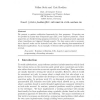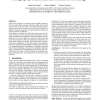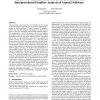105
click to vote
JUCS
2007
15 years 12 days ago
2007
: The technology that supports Aspect-Oriented Programming (AOP) tools is inherently intrusive, since it changes the behavior of base application code. Advice weaving performed by ...
LOBJET
2006
15 years 14 days ago
2006
ABSTRACT. Design patterns are well-known couples of problems-solutions for software engineering. By nature, they often lack support from languages and this further complicates the ...
100
Voted
JUCS
2008
15 years 15 days ago
2008
Abstract: Extending AspectJ to experiment with new language features can be cumbersome, even with an extensible implementation. Often, a language designer only needs a rapid protot...
135
click to vote
ENTCS
2006
15 years 16 days ago
2006
We present a runtime verification framework for Java programs. Properties can be specified in Linear-time Temporal Logic (LTL) over AspectJ pointcuts. These properties are checked...
114
click to vote
SPLC
2007
15 years 1 months ago
2007
Software product lines aim to create highly configurable programs from a set of features. Common belief and recent studies suggest that aspects are well-suited for implementing f...
130
click to vote
AOSD
2008
ACM
15 years 2 months ago
2008
ACM
AspectJ was designed as a seamless aspect-oriented extension of the Java programming language. However, unlike Java, AspectJ does not have a safe type system: an accepted binding ...
138
click to vote
AOSD
2008
ACM
15 years 2 months ago
2008
ACM
Aspect-oriented software presents new challenges for the designers of static analyses. Our work aims to establish systematic foundations for dataflow analysis of AspectJ software....
106
Voted
AOSD
2007
ACM
15 years 4 months ago
2007
ACM
The primary implementations of AspectJ to date are based on a compile- or load-time weaving process that produces Java byte code. Although this implementation strategy has been cr...
101
click to vote
ECOOP
2001
Springer
15 years 5 months ago
2001
Springer
AspectJ™ is a simple and practical aspect-oriented extension to Java™. With just a few new constructs, AspectJ provides support for modular implementation of a range of crosscu...
116
click to vote
AOSD
2003
ACM
15 years 5 months ago
2003
ACM
We define a generic join point model for checking the Law of Demeter (LoD). Join points are trees, pointcuts are predicates over join points, and advice is checked statically sim...




